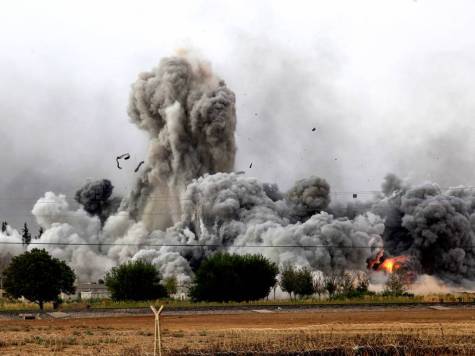Airstrikes in Syria
October 13, 2014
As Syria entered its fourth year in civil war, the United States with the Netherlands, France, Denmark and Arab allies launched airstrikes against the ISIS (Islamic State of Iraq and Syria). The U.S. began its campaign against ISIS on September 22, 2014, after President Obama was granted permission in doing so by Congress. The airstrikes were part of the U.S.’s coalition against ISIS in both Iraq and Syria.
The first wave of strikes in Syria began late Monday, September 6th, that comprised of 47 Tomahawk cruise missiles. These airstrikes targeted eight Khorasan groups located in Northwestern Syria, near Aleppo. From the launched attacks, collateral damage was inflicted on places like training camps, a munitions production center and a communications building. Saudi Arabia, Jordan, United Arab Emirates and Bahrain all participated in the second and third wave of the offense. Through it all, about 200 airstrikes have been conducted in Syria at 22 individual targets.

One recent group that sparked concern for the U.S. was the Khorasan group which was referred to as a small network, comprised of 50 individuals, who were affiliated with the Al-Qaeda. Their mission on mind was to attack the U.S. and Europe for reasons to be. This group consisted of western foreigners who joined the militant group to fight which resulted in being a major threat. This group was considered a problem for they held passports from their home countries, meaning that they had the ability to bring harm onto western countries. Due to this reason, the U.S. had been sharply concerned with this group. In fact, the Khorasan group was so out of hand from the major threat it represented that it was attacked during the first of the three waves. President Obama described this group as the “seasoned Al-Qaeda operatives.”
Even though airstrikes in the multitude have been conducted by a majority of the U.N. countries, they were not the only ones who have been carrying out air assaults in Syria. On September 6, the Syrian government launched a number of airstrikes targeting a stronghold of Islamic State extremists Saturday, killing at least 25 people. Eight airstrikes smashed into buildings in the northeastern city of Raqqa, which were controlled by the Islamist group. At least 16 civilians were killed in the attack, as well as nine Islamic State fighters, according to the Syrian Observatory for Human Rights, which has obtained information from a network of activists on the ground. Raqqa, a city of 500,000 on the banks of the Euphrates, has been virtually out of bounds to journalists since it was captured by the Islamic State earlier this year. In the airstrikes, the U.S. launched missiles that demolished mills and grains storage areas. The British-based Syrian Observatory for Human Rights (BSOHR) believed that the U.S. had mistaken these locations for ISIS bases. According to Rami Abulrahman, who ran the Observatory, “These were workers at the silos. They provide food for the people. The airstrikes destroyed the food that was stored there.”
The purpose of the airstrikes in Syria was to degrade and ultimately destroy the Islamic State. For this to become a reality, the U.S. formed a plan to be the first in directly attacking the ISIS in both Iraq and Syria, severing its supply lines and its source of arms and money. To halt funds from flowing into the hands of the ISIS, the U.S. took a look at what exactly had covered ISIS’s finances. The financial support that ISIS received so far was from the oil fields located in Syria that they had captured from Mr. Assad’s government. These oil fields have made ISIS an estimated $3 million a day. The lose of this control for the ISIS slowed their plans, both present and future, in causing harm to any outside powers.
Through it all, the persistent offenses against the ISIS and its extensions have still been under observance for any suspicious activities and signs of threats to the US and any of its allies. US jets bombed various areas under the Islamic State’s (formerly ISIS/ISIL) control 131 times in Iraq since August 8. The strikes targeted locations near the Mosul Dam and were in support of Erbil operations. CENTCOM stated, “In total, the strikes destroyed an ISIL observation post, one ISIL Humvee, one ISIL armed vehicle, one ISIL truck, and three ISIL mortar positions. All aircraft exited the strike areas safely.”

The Islamic State has continued in attracting worldwide attention in the past months as it made rapid territorial gains in western and northern Iraq, threatening religious and ethnic minorities with death unless they convert to their extreme brand of Islam.
